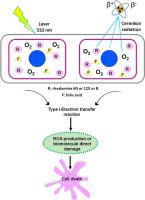Journal of Photochemistry and Photobiology A: Chemistry ( IF 4.1 ) Pub Date : 2021-01-09 , DOI: 10.1016/j.jphotochem.2021.113131 Nallely P. Jiménez-Mancilla , Liliana Aranda-Lara , Enrique Morales-Ávila , Miguel A. Camacho-López , Blanca E. Ocampo-García , Eugenio Torres-García , José A. Estrada-Guadarrama , Clara L. Santos-Cuevas , Keila Isaac-Olivé

|
Rhodamine (R) compounds are photosensitizers with low production of 1O2, so these compounds have not been considered very often for photodynamic therapy (PDT). Rhodamine-6G (R6G) undergoes electron transfer reactions with folic acid (FA). This reaction converts this form of R into a potential photosensitizer (PS) for PDT. The occurrence of this reaction with other R or oxygen has not yet been proven. The low penetrability of visible light into the skin has led to the proposal of a PDT light source alternative to Cerenkov radiation (CR). This work evaluates and compares the occurrence of type-I transfer reactions of R6G, R123, and RB with FA and oxygen when irradiated at 532 nm. The potential use of these compounds as type-I photosensitizers for PDT was also evaluated in vitro by excitation with CR. R electron transfer reactions with FA and oxygen were monitored by emission fluorescence and ultraviolet/visible (UV/Vis) absorption of 2,6-dichlorophenol-indophenol (DCPIP) as a redox indicator, respectively. 177Lu and 18F were used as CR sources. The results showed that the three R compounds underwent type-I transfer reactions with FA in the order R123 > R6G > RB when irradiated at 532 nm. Excitation of R6G using CR was demonstrated. Only R6G showed a type-I reaction with O2. By irradiating T47D tumor cells with a 532 nm laser light, cell death occurred in the order R6G>R123>RB. The same trend was found when cells were irradiated with CR. The possibility of using the type-I reaction between R compounds and biomolecules provides a new perspective in the use of these dyes in PDT.
中文翻译:

罗丹明中的电子转移反应:在光动力疗法中的潜在用途
罗丹明(R)的化合物是具有低生产光敏剂1 Ò 2,所以这些化合物还没有被认为是非常经常用于光动力疗法(PDT)。罗丹明6G(R6G)与叶酸(FA)进行电子转移反应。该反应将这种形式的R转化为潜在的PDT光敏剂(PS)。与其他R或氧的反应尚未得到证实。可见光对皮肤的低渗透性导致提出了替代切伦科夫辐射(CR)的PDT光源的建议。这项工作评估并比较了在532 nm辐射时,R6G,R123和RB与FA和氧气发生的I型转移反应。还评估了这些化合物作为PDT的I型光敏剂的潜在用途在体外用CR激发。与FA和氧的R电子转移反应分别通过发射荧光和作为氧化还原指示剂的2,6-二氯苯酚-吲哚酚(DCPIP)的紫外/可见光(UV / Vis)吸收进行监测。177 Lu和18 F被用作CR源。结果表明,当在532 nm处照射时,三种R化合物与FA进行I型转移反应,顺序为R123> R6G> RB。证明了使用CR激发R6G。只有R6G与O 2表现出I型反应。通过用532nm激光照射T47D肿瘤细胞,以R6G> R123> RB的顺序发生细胞死亡。当用CR照射细胞时,发现了相同的趋势。在R化合物和生物分子之间使用I型反应的可能性为在PDT中使用这些染料提供了新的视角。









































 京公网安备 11010802027423号
京公网安备 11010802027423号